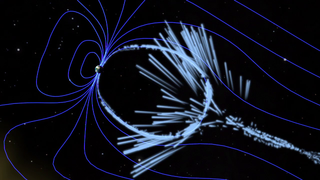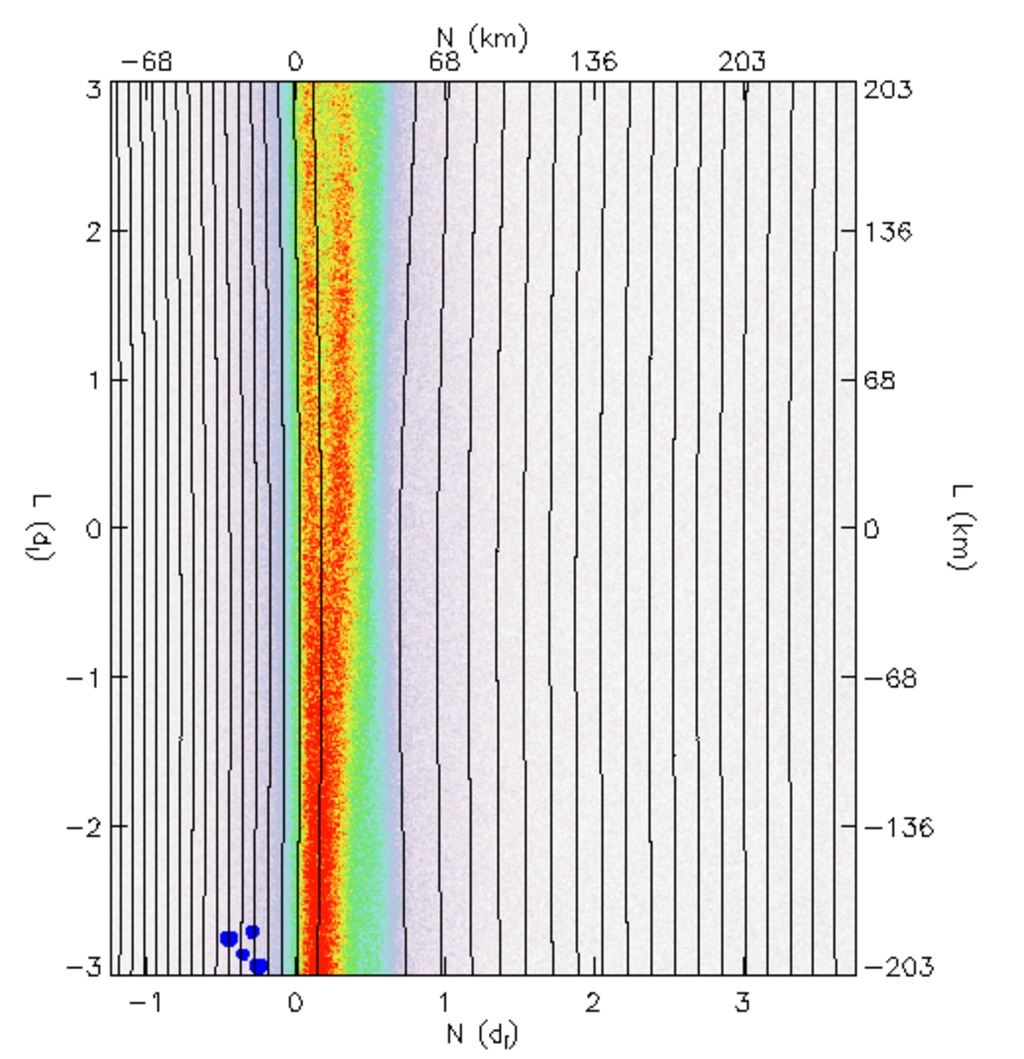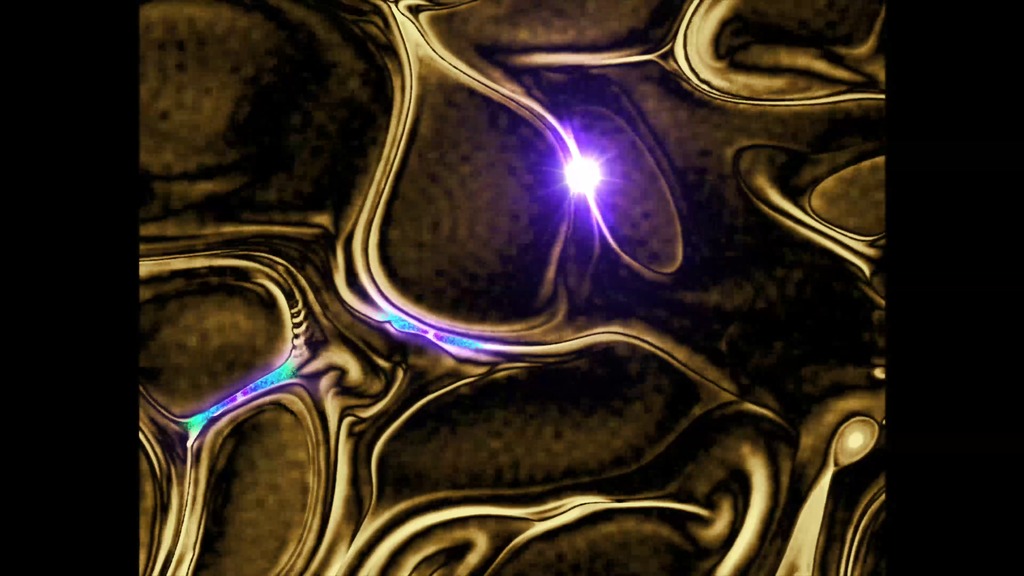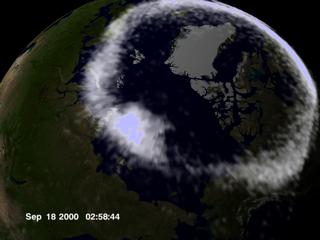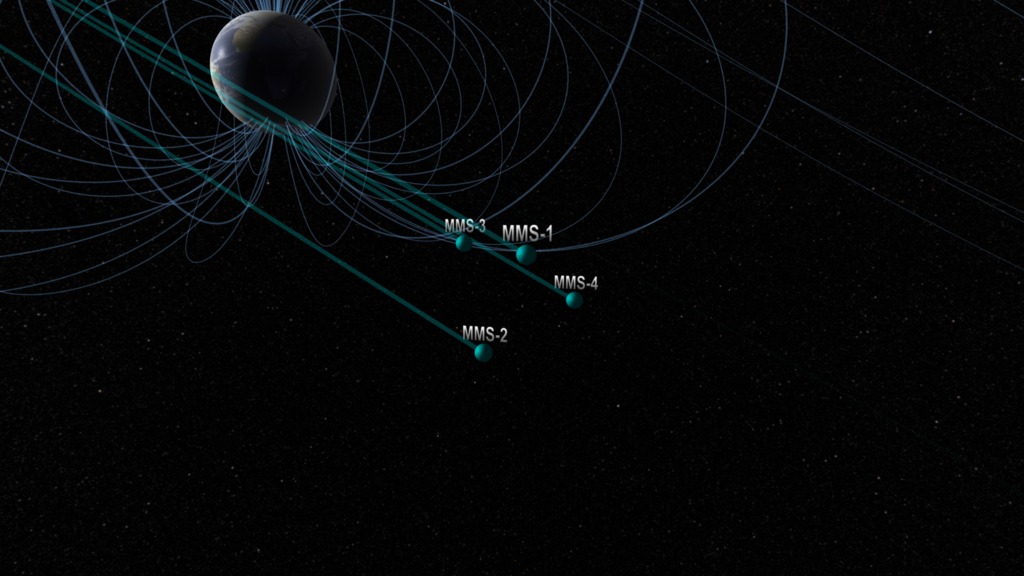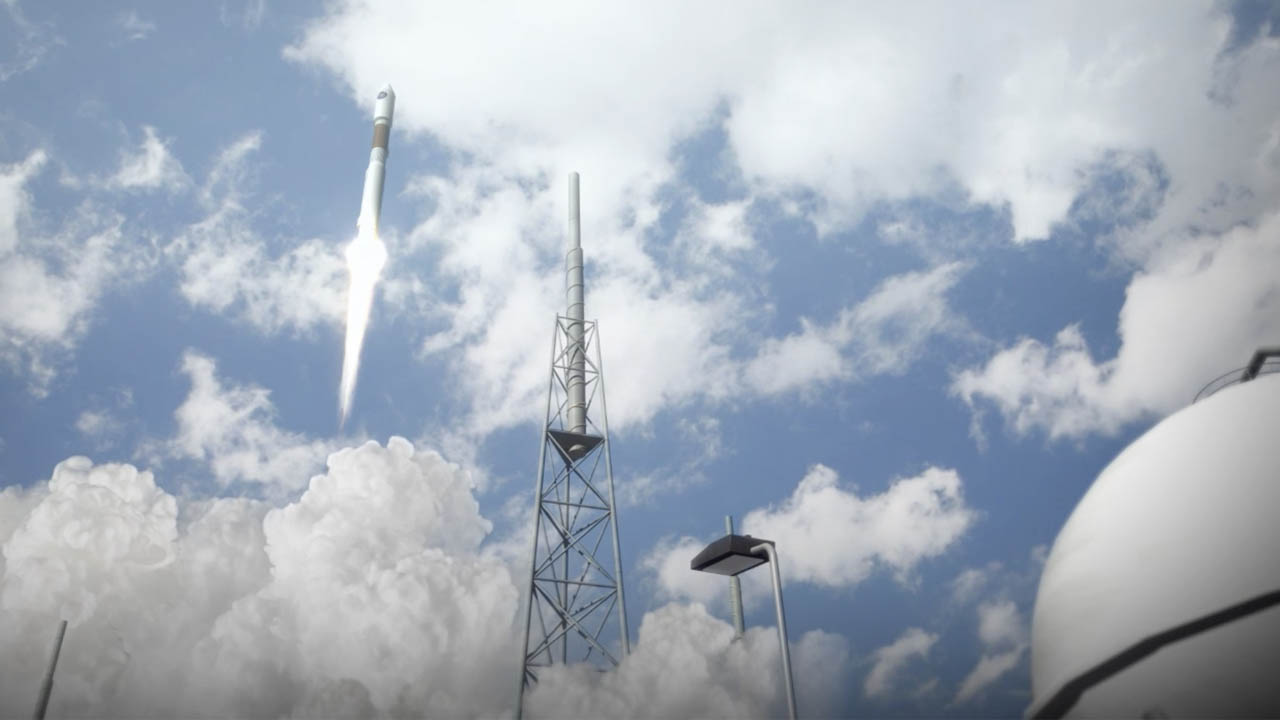Magnetospheric Multiscale (MMS)
Overview
NASA Magnetospheric Multiscale(MMS) Mission Page
What is MMS?
What questions are we answering with MMS?
MMS Narrated Orbit
Go to this pageScientist John Dorelli explains the MMS mission's orbit and why the four spacecraft fly in a tetrahedron formation. On its journey, MMS will observe a little-understood, but universal phenomenon called magnetic reconnection, responsible for dramatic re-shaping of the magnetic environment near Earth, often sending intense amounts of energy and fast-moving particles off in a new direction. Not only is this a fundamental physical process that occurs throughout the universe, it is also one of the drivers of space weather events at Earth. To truly understanding the process, requires four identical spacecraft to track how such reconnection events move across and through any given space in 3D. ||
NASA Administrator and Media to See MMS Mission Progress
Go to this pageNASA Administrator Charles Bolden had a firsthand look at work being done on the Magnetospheric Multiscale (MMS) spacecraft during a visit to the agency's Goddard Space Flight Center in Greenbelt, Maryland, on Monday, May 12, 2014.Bolden visited Goddard's Integration and Test Facility where the four MMS spacecraft are undergoing testing. The spacecraft were in a rare four-stack arrangement inside a clean room after completing vibration testing. The clean room itself was temporarily altered to allow a close-up view of the approximate 20-foot high collection of four observatories in their launch configuration.In addition to Bolden, MMS project personnel were available to answer questions about the mission, ground testing and preps for launch.During its two-year mission, MMS will explore the mystery of how magnetic fields around Earth connect and disconnect, explosively releasing energy — a process known as magnetic reconnection. The four MMS spacecraft will provide the first three-dimensional views of this fundamental process that occurs throughout our universe. ||
MMS Mission Trailer
Go to this pageIn March 2015, NASA will launch four identical spacecraft to study how magnetic fields around Earth connect and disconnect, explosively releasing energy – a process known as magnetic reconnection. The Magnetospheric Multiscale, or MMS, mission will provide the first three-dimensional views of this fundamental process that can accelerate particles to nearly the speed of light. MMS uses Earth’s protective magnetic space environment, the magnetosphere, as a natural laboratory to directly measure reconnection. Reconnection is a common processes in our universe; occurring in space near Earth, in the atmosphere of the sun and other stars, in the vicinity of black holes and neutron stars, and at virtually any boundary between space plasmas, including the boundary between our solar system's heliosphere and interstellar space. ||
Science Results
MMS Sees a New Type of Reconnection
Go to this pageThe Magnetospheric Multiscale (MMS) mission consists of four identical satellites that traverse various regions of Earth's magnetosphere measuring the particles and electric and magnetic field which influence them.In the turbulent plasma between Earth's magnetopause and bow shock, a region called the magnetosheath, the MMS satellite constellation has measured multiple jets of energetic electrons between magnetic bubbles. This appears to be a new 'flavor' of magnetic reconnection based on electrons and occuring on smaller time and spatial scales than the standard model of magnetic reconnection with ions.In these data visualizations, the arrows represent the data collected by the spacecraft. To better comprehend changes as the spacecraft moves along, the data are allowed to 'echo' along the spacecraft trail. The length of the vectors represent the relative magnitude of the vector. However, the electron and proton vectors are scaled so equal velocities correspond to vectors of equal magnitude.Magenta represents the direction and magnitude of the magnetic field at the spacecraft position.Green represents the direction and magnitude of the net electric current created by the motion of the electrons and ions measured at the spacecraft position.The four MMS spacecraft are represented by colored spheres, corresponding to the plotted data lines in the lower graphicMMS1MMS2MMS3MMS4The clocks on MMS are synchronized for the TAI (International Atomic Time) system provided through the Global Positioning System (GPS) satellites. It provides a high-precision time reference for comparing MMS measurements to other datasets. ||
Mapping Particle Injections in Earth's Magnetosphere
Go to this pageA view from above the northern hemisphere of particle injection propagation constructed from their respective satellite detections. Distinct injections, and their detection by satellites, are represented by different colors. || MagnetosphereMultiMission.top.GSE.AU.clockSlate_EarthTarget.HD1080i.01200_print.jpg (1024x576) [115.4 KB] || MagnetosphereMultiMission.top.GSE.AU.clockSlate_EarthTarget.HD1080i.01200_searchweb.png (320x180) [82.7 KB] || MagnetosphereMultiMission.top.GSE.AU.clockSlate_EarthTarget.HD1080i.01200_thm.png (80x40) [6.3 KB] || TopView (1920x1080) [0 Item(s)] || MagnetosphereMultiMission.top.HD1080i_p30.mp4 (1920x1080) [29.7 MB] || MagnetosphereMultiMission.top.HD1080i_p30.webm (1920x1080) [6.1 MB] || TopView (3840x2160) [0 Item(s)] || MagnetosphereMultiMission.top.UHD3840_2160p30.mp4 (3840x2160) [93.0 MB] || MagnetosphereMultiMission.top.HD1080i_p30.mp4.hwshow [207 bytes] ||
Zoom in to MMS and Magnetopause Reconnection
Go to this pageThe visualization starts with an overview of the MMS orbit. || MMSpursuit_Fly2Pursuit2Stop_Oct16data_RE_MMS.slate_RigRHS.HD1080i.0200_print.jpg (1024x576) [91.6 KB] || MMSpursuit_Fly2Pursuit2Stop_Oct16data_RE_MMS.slate_RigRHS.HD1080i.0200_searchweb.png (320x180) [71.3 KB] || MMSpursuit_Fly2Pursuit2Stop_Oct16data_RE_MMS.slate_RigRHS.HD1080i.0200_thm.png (80x40) [4.9 KB] || 1920x1080_16x9_30p (1920x1080) [0 Item(s)] || MMSpursuit_Fly2Pursuit2Stop_Oct16data_HD1080i_p30.mp4 (1920x1080) [81.6 MB] || MMSpursuit_Fly2Pursuit2Stop_Oct16data_HD1080i_p30.webm (1920x1080) [9.3 MB] || 3840x2160_16x9_30p (3840x2160) [0 Item(s)] || MMSpursuit_Fly2Pursuit2Stop_Oct16data.UHD3840p30.mp4 (3840x2160) [238.2 MB] || MMSpursuit_Fly2Pursuit2Stop_Oct16data_HD1080i_p30.mp4.hwshow [270 bytes] ||
Data Tour of MMS and Magnetopause Reconnection
Go to this pageA slow fly-around of the MMS tetrahedral formation to better view the 3-dimensional structure of the data. || MMSpursuit_DataTour_Oct16slow_RE_MMS.slate_RigRHS.HD1080i.1300_print.jpg (1024x576) [144.5 KB] || MMSpursuit_DataTour_Oct16slow_RE_MMS.slate_RigRHS.HD1080i.1300_searchweb.png (320x180) [84.0 KB] || MMSpursuit_DataTour_Oct16slow_RE_MMS.slate_RigRHS.HD1080i.1300_thm.png (80x40) [5.1 KB] || 1920x1080_16x9_30p (1920x1080) [0 Item(s)] || MMSpursuit_DataTour_Oct16slow_HD1080i_p30.mp4 (1920x1080) [94.0 MB] || MMSpursuit_DataTour_Oct16slow_HD1080i_p30.webm (1920x1080) [9.2 MB] || 3840x2160_16x9_30p (3840x2160) [0 Item(s)] || MMSpursuit_DataTour_Oct16slow.UHD3840p30.mp4 (3840x2160) [282.4 MB] || MMSpursuit_DataTour_Oct16slow_HD1080i_p30.mp4.hwshow [207 bytes] ||
Alfvén Waves - Basic
Go to this pageAlfven waves represented by undulation in the magnetic field vector. || AlfvenWaveBasic_staticXwide_inertial.HD1080i.0300_print.jpg (1024x576) [158.5 KB] || AlfvenWaveBasic_staticXwide_inertial.HD1080i.0300_thm.png (80x40) [4.6 KB] || AlfvenWaveBasic_staticXwide_inertial.HD1080i.0300_web.png (320x180) [71.9 KB] || WavesOnly (1920x1080) [128.0 KB] || AlfvenWaveBasic_staticXwide.HD1080i_p30.mp4 (1920x1080) [34.0 MB] || AlfvenWaveBasic_staticXwide.HD1080i_p30.webm (1920x1080) [4.9 MB] ||
Alfvén Waves - Kinetic
Go to this pageKinetic Alfven waves represented by undulation in the magnetic field vector. || AlfvenWaveKinetic_staticXwide_inertial.HD1080i.0300_print.jpg (1024x576) [155.7 KB] || WavesOnly (1920x1080) [128.0 KB] || AlfvenWaveKinetic_staticXwide.HD1080i_p30.mp4 (1920x1080) [37.9 MB] || AlfvenWaveKinetic_staticXwide.HD1080i_p30.webm (1920x1080) [4.9 MB] ||
MMS First Results
Go to this pageThis short video outlines the MMS mission and its first results. Since it launched, MMS has made more than 4,000 trips through the magnetic boundaries around Earth, each time gathering information about the way the magnetic fields and particles move. A surprising result was that at the moment of interconnection between the sun’s magnetic field lines and those of Earth the crescents turned abruptly so that the electrons flowed along the field lines. By watching these electron tracers, MMS made the first observation of the predicted breaking and interconnection of magnetic fields in space. Credit: NASA/GSFCWatch this video on the NASA Goddard YouTube channel. || mmsthumb.jpg (1280x720) [139.4 KB] || mmsthumb_print.jpg (1024x576) [161.8 KB] || mmsthumb_searchweb.png (320x180) [104.3 KB] || mmsthumb_web.png (320x180) [104.3 KB] || mmsthumb_thm.png (80x40) [6.8 KB] || 12239_MMS_First_ResultsV2_appletv.m4v (1280x720) [76.9 MB] || 12239_MMS_First_ResultsV2.webm (1920x1080) [18.1 MB] || 12239_MMS_First_ResultsV2_appletv_subtitles.m4v (1280x720) [77.0 MB] || 12239_MMS_First_ResultsV2.en_US.srt [3.0 KB] || 12239_MMS_First_ResultsV2.en_US.vtt [3.0 KB] || YOUTUBE_HQ_12239_MMS_First_ResultsV2_youtube_hq.mov (1920x1080) [1.1 GB] || 12239_MMS_First_ResultsV2_lowres.mp4 (480x272) [21.6 MB] || 12239_MMS_First_ResultsV2_ipod_sm.mp4 (320x240) [26.3 MB] || PRORES_B-ROLL_12239_MMS_First_ResultsV2_prores.mov (1280x720) [2.2 GB] || 12239_MMS_First_ResultsV2.mov (1920x1080) [4.2 GB] || YOUTUBE_HQ_12239_MMS_First_ResultsV2_youtube_hq.mov.hwshow [100 bytes] ||
Exploring Reconnection - Guide Field Off
Go to this pageThis visualization shows an oblique view of the reconnection region. Magnetic field direction is represented by the cyan lines. The color trail represents an electron moving in the field. Color of the particle trail represents a dimensionless speed of the particle, with blue for slow and red for fast. || GuideFieldOff_oblique_inertial.HD1080i.0300_print.jpg (1024x576) [118.2 KB] || GuideFieldOff_oblique_inertial.HD1080i.0300_searchweb.png (320x180) [70.8 KB] || GuideFieldOff_oblique_inertial.HD1080i.0300_thm.png (80x40) [4.4 KB] || GuideFieldOff_oblique (1920x1080) [0 Item(s)] || GuideFieldOff_oblique_inertial.HD1080i_p30.mp4 (1920x1080) [6.3 MB] || GuideFieldOff_oblique_inertial.HD1080i_p30.webm (1920x1080) [776.5 KB] || GuideFieldOff_oblique_inertial.HD1080i_p30.mp4.hwshow [208 bytes] ||
NASA Spacecraft Finds New Magnetic Process in Turbulent Space
Go to this pageThough close to home, the space immediately around Earth is full of hidden secrets and invisible processes. In a new discovery reported in the journal Nature, scientists working with NASA’s Magnetospheric Multiscale spacecraft — MMS — have uncovered a new type of magnetic event in our near-Earth environment by using an innovative technique to squeeze extra information out of the data.Magnetic reconnection is one of the most important processes in the space — filled with charged particles known as plasma — around Earth. This fundamental process dissipates magnetic energy and propels charged particles, both of which contribute to a dynamic space weather system that scientists want to better understand, and even someday predict, as we do terrestrial weather. Reconnection occurs when crossed magnetic field lines snap, explosively flinging away nearby particles at high speeds. The new discovery found reconnection where it has never been seen before — in turbulent plasma. ||
Magnetic Reconnection
Several NASA Spacecraft Track Energy Through Space
Go to this pageTaking advantage of an unprecedented alignment of eight satellites through the vast magnetic environment that surrounds Earth in space, including NASA's ARTEMIS and THEMIS, scientists now have comprehensive details of the energy's journey through a process that forms the aurora, called a substorm. Their results showed that small events unfolding over the course of a millisecond can result in energy flows that last up to half an hour and cover an area 10 times larger than Earth.Trying to understand how gigantic explosions on the sun can create space weather effects involves tracking energy from the original event all the way to Earth. It's not unlike keeping tabs on a character in a play with many costume changes, because the energy changes form frequently along its journey: magnetic energy causes eruptions that lead to kinetic energy as particles hurtle away, or thermal energy as the particles heat up. Near Earth, the energy can change through all these various forms once again.Most of the large and small features of substorms take place largely in the portion of Earth's magnetic environment called the magnetotail. Earth sits inside a large magnetic bubble called the magnetosphere. As Earth orbits around the sun, the solar wind from the sun streams past the bubble, stretching it outward into a teardrop. The magnetotail is the long point of the teardrop trailing out to more than 1 million miles on the night side of Earth. The moon orbits Earth much closer, some 240,000 miles away, crossing in and out of the magnetotail. ||
Reconnection Fronts - What the Models Say...
Go to this pageMathematical models of Earth's magnetosphere have become increasingly more complex and accurate. They have sufficient detail to illustrate many small-scale phenomena.In this simulation run of the Geospace General Circulation Model (GGCM) we see new details that have been observed by in situ satellites. As the solar wind is deflected around Earth's magnetosphere (the 'bubble' of plasma surrounding Earth held by Earth's magnetic field), plasma flows within the bubble can change. In the graphics below, physical variables such as magnetic field and electric currents are plotted. With these variables, we overlay the net flow of the plasma (arrows), subjected to selection criteria to separate flows of plasma away from Earth and towards Earth. Green arrows are low-speed flows (below about 150 kilometers/second), while red arrows correspond to high-speed plasmal flows (about 300 kilometers/second and higher). ||
Space Weather
Go to this pageThis movie takes us on a space weather journey from the center of the sun to solar eruptions in the sun's atmosphere all the way to the effects of that activity near Earth. The view starts in the core of the sun where atoms fuse together to create light and energy. Next we travel toward the sun's surface, watching loops of magnetic fields rise up to break through the sun's atmosphere, the corona. In the corona is where we witness giant bursts of radiation and energy known as solar flares, as well as gigantic eruptions of solar material called coronal mass ejections or CMEs. The movie follows one of these CME's toward Earth where it impacts and compresses Earth's own protective magnetic bubble, the magnetosphere. As energy and particles from the sun funnel along magnetic field lines near Earth, they ultimately produce aurora at Earth's poles. ||
Magnetic Reconnection 2
Go to this pageThis is an update to an older magnetic reconnection animation (10072). The ionized wind from the Sun generates reconnection in the Earth's magnetic field. Particles leak in from the rediation belts producing the auroras. ||
IMAGE and Cluster View Magnetic Reconnection
Go to this pageThe IMAGE and Cluster spacecraft were ideally positioned in their orbits to view the reconnection event which led to the proton aurora formation. ||
Reconnection: Solar Wind Breaches the Earth's Magnetic Shield
Go to this pageThe Far Ultraviolet camera aboard the IMAGE spacecraft captured this view of a proton aurora (the bright spot near the center of the view) as well as the ring of the electron aurora. The protons for this aurora came from the incoming solar wind. They made it though the Earth's magnetic shield in a magnetic reconnection event higher in the magnetosphere which was detected by the Cluster satellite. Note: A 'corner' appears in the data in the beginning as the IMAGE spacecraft moves into a position where it can view the entire north polar region. ||
X Marks the Spot: SDO Sees Reconnection
Go to this pageTwo NASA spacecraft have provided the most comprehensive movie ever of a mysterious process at the heart of all explosions on the sun: magnetic reconnection. Magnetic reconnection happens when magnetic field lines come together, break apart, and then exchange partners, snapping into new positions and releasing a jolt of magnetic energy. This process lies at the heart of giant explosions on the sun such as solar flares and coronal mass ejections, which can fling radiation and particles across the solar system. Magnetic field lines, themselves, are invisible, but the sun's charged plasma particles course along their length. Space telescopes can see that material appearing as bright lines looping and arcing through the sun’s atmosphere, and so map out the presence of magnetic field lines. Looking at a series of images from the Solar Dynamics Observatory (SDO), scientists saw two bundles of field lines move toward each other, meet briefly to form what appeared to be an “X” and then shoot apart with one set of lines and its attendant particles leaping into space and one set falling back down onto the sun. To confirm what they were seeing, the scientists turned to a second NASA spacecraft, the Reuven Ramaty High Energy Solar Spectroscopic Imager (RHESSI). RHESSI collects spectrograms, a kind of data that can show where exceptionally hot material is present in any given event on the sun. RHESSI showed hot pockets of solar material forming above and below the reconnection point, an established signature of such an event. By combining the SDO and RHESSI data, the scientists were able to describe the process of what they were seeing, largely confirming previous models and theories, while revealing new, three-dimensional aspects of the process. ||
Magnetic Reconnection Throughout the Solar System
Go to this pageMagnetic reconnection at a black hole (fast version) || Blackhole_Sequence_Fast_h264.00288_print.jpg (1024x576) [79.8 KB] || Blackhole_Sequence_Fast_h264.00288_searchweb.png (320x180) [72.4 KB] || Blackhole_Sequence_Fast_h264.00288_thm.png (80x40) [5.0 KB] || Blackhole_Sequence_Fast_h264.mov (3840x2160) [46.2 MB] || Blackhole_Sequence_Fast_h264.webm (3840x2160) [4.6 MB] || blackhole_fast (3840x2160) [0 Item(s)] || Blackhole_Sequence_v04_2160p30.mp4 (3840x2160) [29.9 MB] || Blackhole_Sequence_Fast.mov (3840x2160) [891.0 MB] ||
MMS Orbit Configurations
MMS Spacecraft Transition to Tetrahedral Flying Formation
Go to this pageThis movie illustrates two orbits of the four MMS spacecraft. || Helio2015A.MMSPursuit.fieldlines_RigRHS.HD1080i.0570_print.jpg (1024x576) [111.7 KB] || Helio2015A.MMSPursuit.fieldlines_RigRHS.HD1080i.0570_searchweb.png (320x180) [72.4 KB] || Helio2015A.MMSPursuit.fieldlines_RigRHS.HD1080i.0570_thm.png (80x40) [4.3 KB] || 1920x1080_16x9_30p (1920x1080) [0 Item(s)] || Helio2015A.MMSPursuit.fieldlines.HD1080.webm (1920x1080) [5.8 MB] || Helio2015A_1080p30.mp4 (1920x1080) [79.2 MB] || Helio2015A.MMSPursuit.fieldlines.HD1080.mov (1920x1080) [313.6 MB] ||
MMS Phase 2b: Transitioning to Magnetosphere Science on the Darkside
Go to this pageVisualization of the spacecraft orbit transition from apogee at the dayside magnetopause to the nightside magnetopause. || MMSPhase2b_Pole_Jan2May2017_RE_GSE.slate_GSEtour.UHD3840.3660_print.jpg (1024x576) [103.1 KB] || MMSPhase2b_Pole_Jan2May2017_RE_GSE.slate_GSEtour.UHD3840.3660_searchweb.png (320x180) [72.9 KB] || MMSPhase2b_Pole_Jan2May2017_RE_GSE.slate_GSEtour.UHD3840.3660_thm.png (80x40) [5.2 KB] || MMSPhase2b_Pole_Jan2May2017_Fast.HD1080i_p30.webm (1920x1080) [23.0 MB] || FastVersion (1920x1080) [0 Item(s)] || MMSPhase2b_Pole_Jan2May2017_Fast.HD1080i_p30.mp4 (1920x1080) [140.4 MB] || FastVersion (3840x2160) [0 Item(s)] || MMSPhase2b_Pole_Jan2May2017.UHD3840_2160p30.mp4 (3840x2160) [449.6 MB] || MMSPhase2b_Pole_Jan2May2017_Fast.HD1080i_p30.mp4.hwshow [210 bytes] ||
Spacecraft Animations
MMS Launch and Deploy - Narrated
Go to this pageIn March of 2015, an unprecedented NASA mission will launch to study a process so mysterious that no one has ever directly measured it in action. To create the first-ever 3-dimensional maps of this process, a process called magnetic reconnection, which occurs all over the universe, the Magnetospheric Multiscale, or MMS, mission uses four separate spacecraft equipped with ultra high speed instruments. Launching four satellites into space simultaneously is a complicated process. In addition, each spacecraft has six booms that will unfold and extend in space once in orbit. A launch and deployment with so many moving parts must be meticulously planned. Watch the video to get a sneak preview of how MMS will make this journey: The four spacecraft are housed in a single rocket on their trip into space. One by one, each ejects out, before moving into a giant pyramid-shaped configuration. Next each spacecraft deploys its six booms. Once in orbit, MMS will fly through regions near Earth where this little-understood process of magnetic reconnection occurs. Magnetic reconnection happens in thin layers just miles thick, but can tap into enough power at times to create gigantic explosions many times the size of Earth. Reconnection happens when magnetic field lines explosively realign and release massive bursts of energy, while hurling particles out at nearly the speed of light in all directions. Magnetic reconnection powers eruptions on the sun and – closer to home – triggers the flow of material and energy from interplanetary space into near-Earth space. The MMS orbit will carry the four spacecraft through reconnection regions near Earth, using this nearby natural laboratory to better understand how reconnection occurs everywhere in space. For more information about MMS, visit: www.nasa.gov/mms ||
MMS Spacecraft Animation
Go to this pageThe Magnetospheric Multiscale (MMS) mission is a Solar Terrestrial Probes mission comprising four identically instrumented spacecraft that will use Earth’s magnetosphere as a laboratory to study the microphysics of three fundamental plasma processes: magnetic reconnection, energetic particle acceleration, and turbulence. These processes occur in all astrophysical plasma systems but can be studied in situ only in our solar system and most efficiently only in Earth’s magnetosphere, where they control the dynamics of the geospace environment and play an important role in the processes known as “space weather.”Learn more about MMS at www.nasa.gov/mms ||
MMS Launch and Deployment
Go to this pageThis animation follows Magnetosphere Multiscale(MMS) Mission from launch at Kennedy Space Center through deployment and on station doing science. The MMS mission is comprising four identically instrumented spacecraft that will use Earth’s magnetosphere as a laboratory to study the microphysics of three fundamental plasma processes: magnetic reconnection, energetic particle acceleration, and turbulence. ||
MMS front side reconnection
Go to this pageThis animation show the MMS spacecraft transiting through a reconnection event on the front side of Earth. || MMS frontside reconnection animation || recon_59_94_264_print.jpg (1024x576) [125.4 KB] || recon_30fps_422.webm (1920x1080) [1.7 MB] || recon_30fps_422.mov (1920x1080) [251.4 MB] || recon_59_94_422.mov (1920x1080) [501.3 MB] || recon_59_94_264.mov (1920x1080) [585.0 MB] || mms-front-side-reconnection-animation.hwshow [289 bytes] ||
Engineering
3 Days in 1 Minute: Stacking the MMS Spacecraft
Go to this pageThe Magnetospheric Multiscale, or MMS, mission stacked all four of its spacecraft in preparation for vibration testing. This time lapse shows one image every thirty seconds over three days of work. First, the spacecraft are assembled into mini-stacks, or placed on top of each other in sets of two. To create a full stack, engineers lift one mini-stack on top of another.Vibration testing simulates the conditions that the MMS spacecraft will experience during launch.MMS will study how the sun and the Earth's magnetic fields connect and disconnect, an explosive process that can accelerate particles through space to nearly the speed of light. This process is called magnetic reconnection and can occur throughout all space. ||
MMS: Engineering Challenges
Go to this pageIt's hard enough to build one spacecraft, but the Magnetospheric Multiscale Mission (MMS) is building four. Together, the spacecraft will unlock the mysteries of magnetic reconnection, when magnetic fields explosively connect and disconnect, transferring energy. ||
MMS Spin Test
Go to this pageThe four MMS observatories each undergo what's called a spin test, to learn how well the spacecraft is balanced. Italso provides information on how well the mass properties of an observatory can be measured and aligned. This movie shows Observatory #4 undergoing the test in May 2013 on the MRC Mark V spin balance machine. After launch, the MMS observatories will spin at approximately 3 revolutions per minute during normal operations. ||
Pre-Launch Videos
Magnetospheric Multiscale Mission (MMS) Dayside Orbit Animation for the Preliminary Design Review (PDR)
Go to this pageThis visualization uses simulated ephemerides to show the proposed orbits of the Magnetospheric Multiscale Mission (MMS) during the "dayside magnetosheath/magnetopause" orbit phase. The movie initially shows the general orientation of the orbit with respect to the Earth, Moon, and Sun. It then zooms in to "ride" along with the spacecraft. We then zoom in even closer to show that there are actually four spacecraft flying in a tetrahedral formation. Finally, we see how the 4 spacecraft skim the magnetosheath such that, occasionally, some of the spacecraft are inside (e.g., MMS #1) and some are outside (e.g., MMS #2, #3, and #4) of the magnetosheath boundary.This visualization was created in support of the MMS Preliminary Design Review (PDR) which was held May 4 - 7, 2009. ||
Magnetospheric Multiscale Mission (MMS) Nightside Orbit Animation for the Preliminary Design Review (PDR)
Go to this pageThis visualization uses simulated ephemerides to show the proposed orbits of the Magnetospheric Multiscale Mission (MMS) during the "nightside" orbit phase. The movie initially shows the general orientation of the orbit with respect to the Earth, Moon, and Sun. It then moves in towards the Earth revealing Earth's magnetic field. The camera then moves down towards the dark side of the Earth showing how MMS will fly through the tail of the magnetosphereThis visualization was created in support of the MMS Preliminary Design Review (PDR) which was held May 4th through May 7th of 2009. ||
